- Books Name
- ACME SMART COACHING Biology Book
- Publication
- ACME SMART PUBLICATION
- Course
- CBSE Class 11
- Subject
- Biology
THE FLOWER
Flower is defined as a highly condensed and modified reproductive shoot.
Instead of leaves the apex produces different kinds of floral appendages laterally at successive nodes.
Following points can be mentioned to justify that flower is a modified shoot:
(1) Calyx, corolla, androecium and gynoecium represent four whorls of sterile and fertile leaf modifications borne at different nodes.
Sometimes, internode between calyx and corolla becomes elongated and called as anthophore, e.g., Silene Dianthus.
The internode between corolla and androecium is known as androphore, e.g., Passiflora.
The internode between androecium and gynoecium is called as gynophore e.g., Capparis.
When androphore and gynophore both are present in the same flower they are jointly termed as gynandrophore e.g., Cleome gynandra.
The prolongation of thalamus beyond carpel is known as carpophore, e.g., Coriandrum, Foeniculum.
(2) In Mussaenda, one sepal enlarges to form leafy structure (foliaceous sepal).
(3) Sometimes, floral bud gets transformed into vegetative bud or bulbil. e.g., Agave.
Concept Builder
Terminology used w.r.t. flower
(i) Complete flower: All four whorls (calyx, corolla, androecium and gynoecium) are present.
(ii) Incomplete flower: Flower with anyone of the four whorls missing.
(iii) Bisexual flower: Both gynoecium and androecium are present in the same flower.
(iv) Unisexual flower: Either androecium (staminate flower) or gynoecium (pistillate flower) is present in the flower.
(v) Monoecious plant: When both male and female flowers are present on the same plant e.g., Cocos, Ricinus, Zea, Colocasia, Acalypha.
(vi) Dioecious plant: When male and female flowers are present on separate plants e.g., Mulberry, Papaya.
(vii) Polygamous plant: When unisexual (male or female) , bisexual and neuter flowers are present on the same plant e.g., Polygonum, Mango.
(viii) Achlamydeous flower: Flowers are naked i.e., without sepals and petals e.g., Piperaceae.
(ix) Monochlamydeous flower :Only one whorl is present (perianth) e.g., Polygonaceae, Liliaceae.
(x) Dichlamydeous flower: Both whorls (calyx and corolla) present in a flower e.g., most of the flowers.
(xi) Hemicyclic or spirocyclic flowers: Some of the floral parts form circles and some are spirally arranged e.g., Ranunculaceae.
(xii) Cauliflory: Production of flowers on old stem from dormant buds e.g., Artocarpus, Ficus.
Symmetry of Flower
(i) Actinomorphic flower. When a flower can be divided into two equal halves by many vertical sections passing through the centre. e.g., Cruciferae, Malvaceae.
(ii) Zygomorphic flower. When a flower can be divided into two equal halves by only one vertical section passing through the centre. e.g., Pea.
Position of Floral Parts on Thalamus
(i) Hypogyny. Ovary is at the top and separable from thalamus. Such flowers are called hypogynous and ovary is said to be superior. e.g. , Malva, Brassica.
(ii) Perigyny. Ovary is situated in centre and other parts of the flower are located on the rim of thalamus, almost at the same level. Ovary is half superior, half inferior. e.g., Rose.
(iii) Epigyny. Calyx and corolla arise from upper side of ovary. Ovary is completely surrounded by and fused with thalamus. Ovary is called inferior and flower is said to be epigynous e.g., Aster, Luffa.
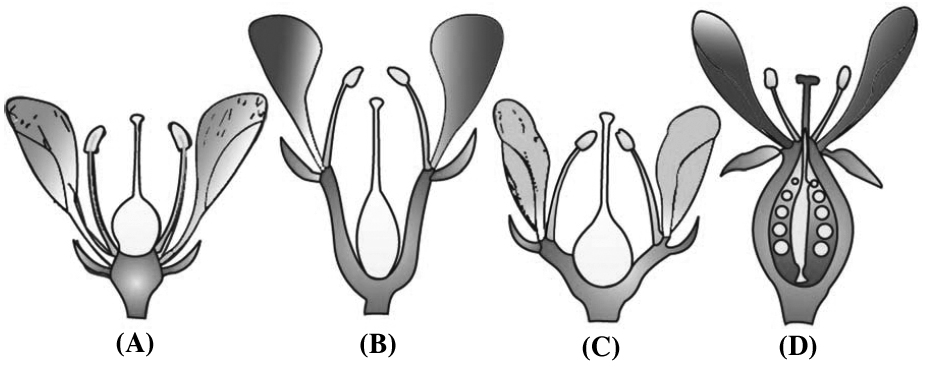
(A) Hypogynous, (B) and (C) Perigynous, (D) Epigynous
Bracts
Bracts are specialized leaves bearing flower in the axil. They are of following types:
(i) Petaloid bracts. Bracts look like petals (brightly coloured). e.g., Bougainvillea.
(ii) Spathy bract. This is large bract enclosing an inflorescence. e.g., Banana, Maize, Palms.
(iii) Foliaceous bracts. Bracts are leaf like in appearance e.g., Adhatoda, Gynandropsis.
(iv) Involucre. They are green coloured and in one or more whorls around or below the entire inflorescence. e.g., Sunflower, Coriander.
(v) Glumes. These are small, dry, scaly bracts found in spikelet of Gramineae. e.g., Wheat.
All floral whorls are described respectively :
A. Calyx
Outermost whorl of a flower is called calyx. It is the non-essential whorl and consists of sepals. Sepals may be free (polysepalous) or fused (gamosepalous). Sepals are modified as follows :
(i) Pappus. Sepals are modified into persistent hairy structures called pappus which help in dispersal of fruits. e.g., Sunflower, Sonchus. (Asteraceae) .
(ii) Leafy. In Mussaenda, one sepal gets modified into large leaf like white structure.
(iii) Spinous. In Trapa , the calyx is persistent and modified into two spines.
B. Corolla
It is second whorl of flower and consists of a number of petals which are usually bright coloured. The petals may be fused (gamopetalous) or free (polypetalous).
Concept Builder
Various forms of petals are :
(i) Cruciform. Four petals arranged like a cross e.g. , members of Brassicaceae.
(ii) Papilionaceous. Number of petals is five with largest petal standard or vexillum, enclosing two lateral petals called wings or alae which are free, these in turn enclose the inner most petals called keel or carina (united petals) , e.g. , Pea.
(iii) Caryophyllaceous. Five, free, long, clawed corolla, with limbs spreading at right angles to claws. e.g., Dianthus.
(iv) Tubular. Petals are like a tube, e.g. , disc florets of sunflower.
(v) Campanulate or bell shaped. Petals are like a bell, e.g., Physalis.
(vi) Infundibuliform or funnel shaped. Petals are like funnel, e.g., Datura .
(vii) Bilabiate (two lipped). Upper and lower lips are formed by fusion of petals, e.g., Salvia, Ocimum.
(viii) Ligulate or strap shaped. Gamopetalous petals forming tongue like structure, e.g., Ray florets of Sunflower.
(ix) Personate. Corolla is bilabiate, but the lips are so near to each other as to close the mouth of the corolla, e.g., Antirrhinum.
Aestivation
Arrangement of floral parts in a floral bud with respect to the other members of the same whorl is known as aestivation. It may be of following types.
(i) Valvate. When sepals or petals lie very close to each other, without overlapping e.g., Mustard.
(ii) Twisted or contorted. When one margin of the sepal or petal overlaps the margin of next and other margin is overlapped by the third one. e.g., China rose.
(iii) Imbricate. When both margins of one of the petals are covered by others and both margins of another one are external and of the remaining partly internal, partly external. e.g., Cassia, Caesalpinia.
(iv) Quincuncial. When two petals are inner, two are outer and one is partly outer and partly inner e.g., Ranunculus.
(v) Vexillary. The posterior one is largest and almost covers the two lateral petals and the latter in turn nearly overlap the two anterior petals, e.g. , Pea (Papilionaceae).
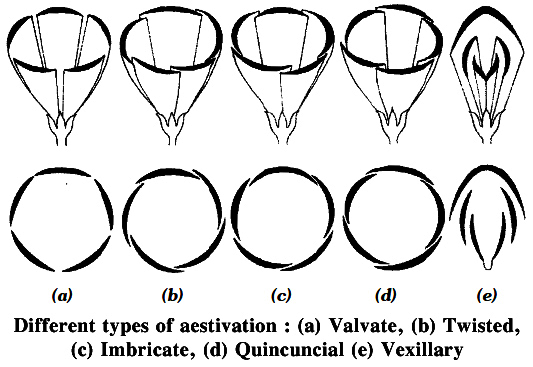
C. Androecium
Androecium is the third and male whorl of the flower and is made up of one or more stamens (equivalent to microsporophylls).
Each stamen consists of filament, anther and connective. The two lobed anther is called bithecous anther e.g., Pea.
The anther with one lobe is called monothecous anther. e.g., members of Malvaceae.
When stamens are free from each other the condition is called polyandrous, e.g., lily, mustard.
A sterile stamen is called staminode.
Cohesion of Stamens
Fusion of stamens among themselves is called cohesion.
(i) Monadelphous. Stamens may be united by means of their filaments in one bundle with free anthers. e.g., China rose, lady's finger, cotton (Malvaceae).
(ii) Diadelphous. When the filaments are united into two bundles and the anthers remain free, e.g., Pea, bean, gram (Papilionaceae).
(iii) Polyadelphous. When the filaments are united into more than two bundles but anthers are free e.g., Castor (Euphorbiaceae), Lemon (Rutaceae)
(iv) Syngenesious. When anthers are united but the filaments are free, e.g., Sunflower (Compositae).
(v) Synandrous. When anthers as well as filaments of stamens are united throughout their whole length, e.g. , members of Cucurbitaceae.
Adhesion of Stamens
Fusion of stamens with other floral parts.
(i) Epipetalous. When stamens are united to the petals. e.g., China rose, Solanum, Sunflower.
(ii) Episepalous. When stamens are united to sepals. e.g., Verbena.
(iii) Epiphyllous (Epitepalous). When stamens are united to perianth (Tepal). e.g., members of Liliaceae.
(iv) Gynandrous. When stamens are attached to gynoecium (carpel) either throughout their whole length or by their anthers only, e.g., Calotropis, (forming gynostegium).
Length and arrangement of Stamens
(i) Didynamous. 4 stamens, two outer small and two inner long, e.g., Ocimum, Salvia (Lamiaceae).
(ii) Tetradynamous. 6 stamens, two outer small and four inner long, e.g., Mustard, Radish (Brassicaceae).
(iii) Heterostemony. Stamens are of different lengths, e.g., Cassia.
Concept Builder
Obdiplostemonous condition:
Two whorls of stamens, outer lying opposite to the petals (anti-petalous) and inner whorl lying opposite to sepals (anti-sepalous), e.g., Stellaria, Spergula and members of Rutaceae.
Diplostemonous condition:
Two whorls of stamens, outer whorl lying opposite to sepals (antisepalous) and inner whorl lying opposite to petals (antipetalous), e.g., Cassia.
D. Gynoecium
It is the female part of flower comprising of carpels bearing ovules.
It consists of ovary, style and stigma.
The gynoecium may be monocarpellary (one carpel) or polycarpellary (many carpels).
Cohesion of Carpels
(i) Apocarpous. Carpels are free (no cohesion), e.g., Ranunculaceae.
(ii) Syncarpous. Carpels more than two and fused, e.g., most of the plants.
Number of locules. Ovary has locules or chambers having ovules and may be unilocular, bilocular, trilocular, tetralocular or pentalocular (multilocular).
Placentation
The arrangement of ovules on placenta within the ovary is called placentation.
It is of following types:
(i) Marginal. Placenta developing along the junction of the two margins of the carpel in one chambered ovary. It is characteristic feature of family Leguminosae. e.g., Pea, gram.
(ii) Axile. The ovary is two to many chambered and placenta bearing ovules develop from the central axis e.g., Tomato, orange, cotton, china rose, lily. (A)
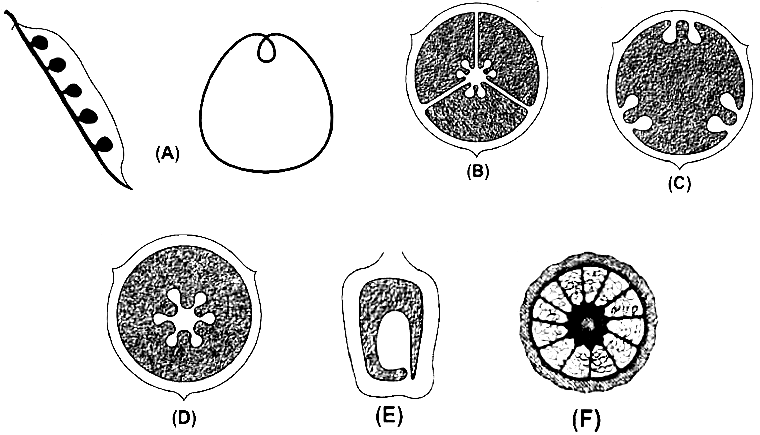
(E) Basal; (F) Superficial
(iii) Parietal. Ovary is one chambered and the placenta bearing the ovules develop close to the inner wall of the ovary, e.g., Mustard, radish, cucumber, Argemone.
(iv) Free central. Ovary is one chambered and the placenta bearing the ovules develop all round the central axis. Septa are absent, e.g., Dianthus, Stellaria.
(v) Basal. Ovary is unilocular and the placenta develops at the base of ovary on thalamus and bears a single ovule, e.g. , Wheat, maize, Aster, Zinnia, sunflower. It is most advanced.
(vi) Superficial. Ovary is multilocular with numerous carpels as in axile type of placentation but placenta develops all round the inner surface of the partition wall, e.g., Water lily. It is most primitive.
Style. It is generally terminal but may be lateral, e.g., Poaceae, mango.
Gynobasic style arises from base of the ovary, e.g., Lamiaceae.
The Flower
In angiosperms, the flower is the reproductive unit. It's designed to be used for sexual reproduction. On the swollen end of the stalk or pedicel, called the thalamus or receptacle, a typical flower has four different kinds of whorls placed sequentially. Calyx, corolla, androecium, and gynoecium are the four flower parts. Androecium and gynoecium are reproductive organs, while calyx and corolla are accessory organs. The calyx and corolla of some flowers, such as lilies, are not distinct and are referred to as perianth. A flower is bisexual if it has both androecium and gynoecium. Unisexual flowers are those that have only stamens or carpels.
The flower can be actinomorphic (radial symmetry) or zygomorphic (bilateral symmetry). Flowers that have multiple lines of symmetry (like a starfish) are radially symmetrical, also called actinomorphic. Flowers with only a single line of symmetry are bilaterally symmetrical, also called zygomorphic. Actinomorphic flowers, such as mustard, datura, and chilli, can be divided into two equal radial halves in any radial plane running through the centre. It is zygomorphic when it can be separated into two comparable halves only in one vertical plane, as in pea, Gulmohar, bean, and Cassia. If a flower, like canna, cannot be divided into two comparable halves by any vertical plane going through the centre, it is asymmetric (irregular).
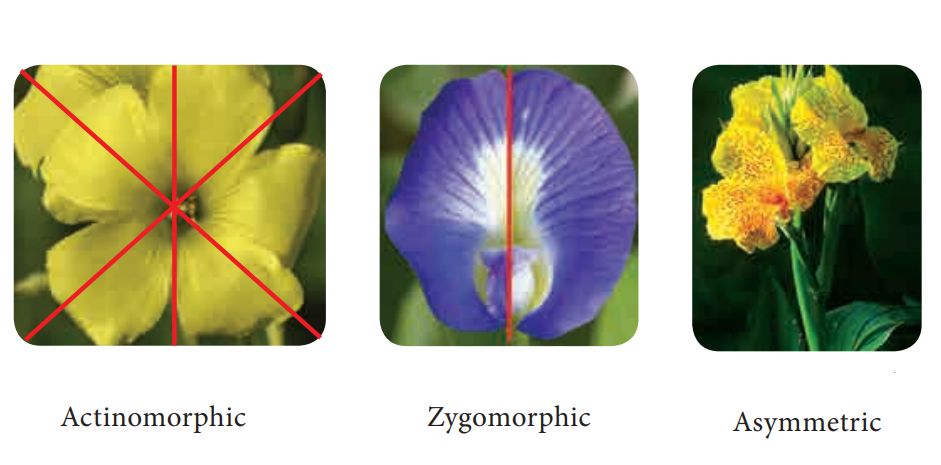
Trimerous, tetramerous, and pentamerous flowers have floral appendages in multiples of 3, 4, and 5, respectively. Bracteate flowers have a shortened leaf at the base of the pedicel, whereas ebracteate flowers do not have one. Flowers are classified as hypogynous, perigynous, or epigynous based on the position of the calyx, corolla, and androecium in relation to the ovary on the thalamus. The gynoecium is at the top of the hypogynous flower, with the other sections below it. Such flowers, such as mustard, China rose, and brinjal are said to have superior ovaries. If the gynoecium is in the center and the other parts of the flower are virtually at the same level as the thalamus rim, the flower is said to be perigynous.Plum, rose, and peach, for example, have a half inferior ovary. The thalamus margin develops upward in epigynous flowers, entirely enclosing and fusing with the ovary; the other parts of the flower ascend above the ovary. As a result, the ovary is reported to be inferior in guava and cucumber flowers, as well as sunflower ray florets.

Parts of a flower include:

Calyx: The calyx is the flower's outermost whorl, and the sepals are its members. Sepals are green, leaf-like structures that protect the flower at the bud stage. The calyx can be gamosepalous (sepals together) or polysepalous (sepals apart) (sepals free).
Corolla: Petals make up the corolla. Petals are typically vividly coloured to attract pollinating insects. Corollas can be gamopetalous (petals joined) or polypetalous, just as the calyx (petals free). Plants have a wide range of corolla shapes and colours. Tubular, bell-shaped, funnel-shaped, or wheel-shaped corollas are all possible.
Aestivation refers to the way sepals or petals in a floral bud are arranged in relation to the other members of the same whorl. Valvate, twisted, imbricate, and vexillary aestivation are the most common kinds. Valvate describes a whorl in which the sepals or petals only touch at the margin, without overlapping, as in Calotropis. Twisted means that one appendage's edge overlaps the next and so on, as in the china rose, lady's finger, and cotton. Imbricate aestivation occurs when the borders of sepals or petals overlap but not in any specific direction, as in Cassia and Gulmohar.The largest (standard) petal overlaps the two lateral petals (wings), which overlap the two smallest anterior petals (keel) in pea and bean flowers; this type of aestivation is known as vexillary or papilionaceous.
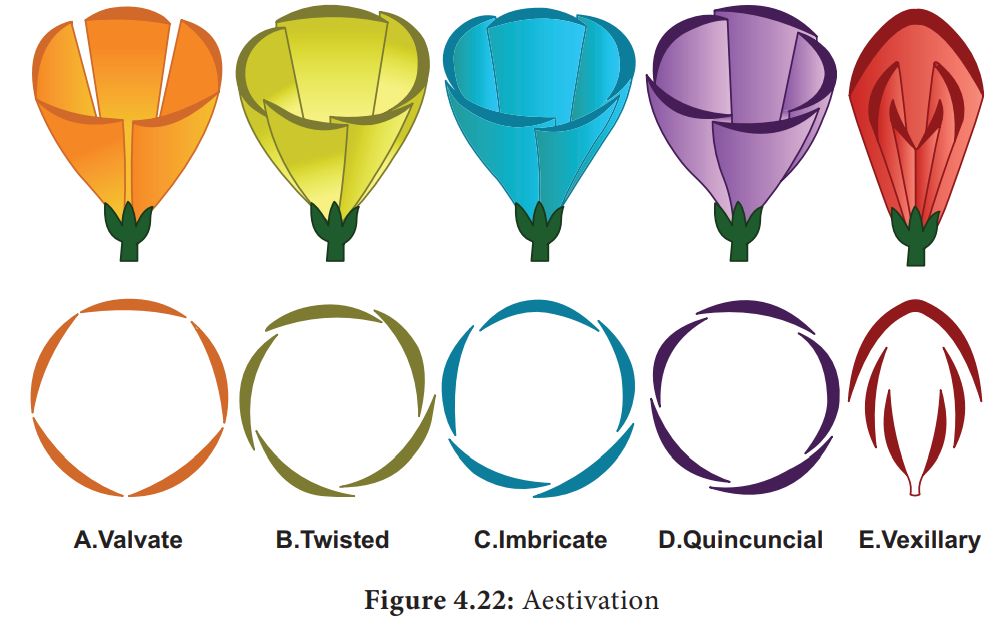
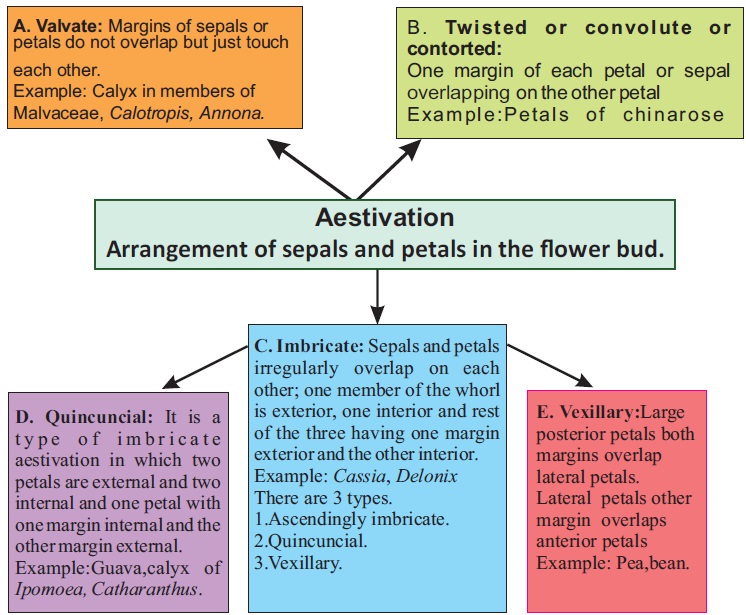
Androecium: Stamens make up the androecium. A stalk or filament and an anther make up each stamen, which represents the male reproductive organ. Each anther is normally bilobed, with two pollen-sac chambers in each lobe. Pollen grains are manufactured in pollen sacs. The staminode is a sterile stamen. Flower stamens can be joined to other components of the flower, such as petals, or to each other. Stamens are epipetalous when attached to the petals, as in brinjal, or epiphyllous when attached to the perianth, as in lily flowers. A flower's stamens can either remain free (polyandrous) or be joined to varying degrees.The stamens can be grouped into a single bunch or bundle (monoadelphous), two bundles (diadelphous), or more than two bundles (polyadelphous) as in China rose. Within a flower, filament length can vary, as in the case of Salvia and mustard.
Gynoecium: The female reproductive component of the flower is the gynoecium, which is made up of one or more carpels. The stigma, style, and ovary are the three sections of a carpel. The expanded basal portion of the ovary is where the elongated tube, the style, is located. The ovary is linked to the stigma by the style. The stigma is the receptive surface for pollen grains and is usually found at the tip of the style. One or more ovules are linked to a flattened, cushion-like placenta in each ovary. When more than one carpel is present, it is referred to as apocarpous as in lotus and rose. When carpels fuse, as in mustard and tomato, they are called syncarpous.The ovules develop into seeds after fertilization, and the ovary matures into a fruit.
Placentation is defined as the placement of ovules within the ovary. There are several varieties of placentation: marginal, axile, parietal, basal, central, and free central. The placenta forms a ridge along the ventral suture of the ovary in marginal placentation, and the ovules are carried in two rows on this ridge, as in pea. The placenta is considered to be axile when the placenta is axial and the ovules are linked to it in a multilocular ovary, as in the China rose, tomato, and lemon. The ovules develop on the inner wall of the ovary or on the peripheral region in parietal placentation. In mustard and Argemone, the ovary is one-chambered but becomes two-chambered due to the creation of the false septum.The placentation is called free central when the ovules are borne on the central axis and the septa are missing, as in Dianthus and Primrose. As in sunflower and marigold, the placenta develops at the base of the ovary and is linked to a single ovule.
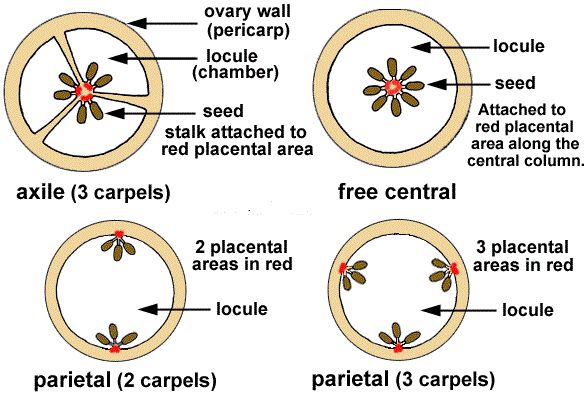

 ACME SMART PUBLICATION
ACME SMART PUBLICATION
